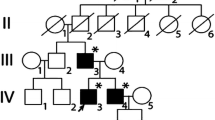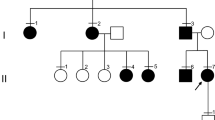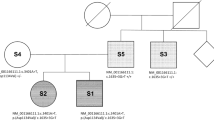Abstract
Episodic ataxia type 2 (EA2) is characterized by recurrent attacks of vertigo and ataxia lasting hours triggered by emotional stress or exercise. Although interictal horizontal gaze-evoked nystagmus and rebound nystagmus are commonly observed in patients with EA2, the nystagmus has been rarely reported during the vertigo attack. To better describe exercise-induced nystagmus in EA2, four affected members from three generations of a Korean family with EA2 received full neurological and neuro-otological evaluations. Vertigo was provoked in the proband with running for 10 min to record eye movements during the vertigo attack. We performed a polymerase chain reaction-based direct sequence analysis of all coding regions of CACNA1A in all participants. The four affected members had a history of exertional vertigo, imbalance, childhood epilepsy, headache, and paresthesia. The provocation induced severe vertigo and imbalance lasting several hours, and oculography documented pure downbeat nystagmus during the attack. Genetic analyses identified a nonsense mutation in exon 23 which has been registered in dbSNP as a pathogenic allele (c.3832C>T, p.R1278X) in all the affected members. Ictal downbeat nystagmus in the studied family indicates cerebellar dysfunction during the vertigo attack in EA2. In patients with episodic vertigo and ataxia, the observation of exercise-induced nystagmus would provide a clue for EA2.



Similar content being viewed by others
References
Jen JC, Graves TD, Hess EJ, Hanna MG, Griggs RC, Baloh RW, CINCH investigators (2007) Primary episodic ataxias: diagnosis, pathogenesis and treatment. Brain 130:2484–2493
Choi KD, Yook JW, Kim MJ et al (2013) Possible anticipation associated with a novel splice site mutation in episodic ataxia type 2. Neurol Sci 34:1629–1632
Yue Q, Jen JC, Thwe MM, Nelson SF, Baloh RW (1998) De novo mutation in CACNA1A caused acetazolamide-responsive episodic ataxia. Am J Med Genet 77:298–301
Pierrot-Deseilligny C, Milea D (2005) Vertical nystagmus: clinical facts and hypotheses. Brain 128:1237–1246
Kim HJ, Kim JS, Choi JH, Shin JH, Choi KD, Zee DS (2014) Rebound upbeat nystagmus after lateral gaze in episodic ataxia type 2. Cerebellum 13:411–413
Kim JM, Kim JS, Ki CS, Jeon BS (2006) Episodic Ataxia Type 2 due to a Deletion Mutation in the CACNA1A Gene in a Korean Family. J Clin Neurol 2:268–271
Zafeiriou DI, Lehmann-Horn F, Vargiami E, Teflioudi E, Ververi A, Jurkat-Rott K (2009) Episodic ataxia type 2 showing ictal hyperhidrosis with hypothermia and interictal chronic diarrhea due to a novel CACNA1A mutation. Eur J Paediatr Neurol 13:191–193
Raike RS, Weisz C, Hoebeek FE et al (2013) Stress, caffeine and ethanol trigger transient neurological dysfunction through shared mechanisms in a mouse calcium channelopathy. Neurobiol Dis 50:151–159
Fureman BE, Hess EJ (2005) Noradrenergic blockade prevents attacks in a model of episodic dysfunction caused by a channelopathy. Neurobiol Dis 20:227–232
Timofeeva E, Huang Q, Richard D (2003) Effects of treadmill running on brain activation and the corticotropin-releasing hormone system. Neuroendocrinology 77:388–405
Jeong YG, Chung SH, Kim CT et al (2006) Corticotropin-releasing factor immunoreactivity increases in the cerebellar climbing fibers in the novel ataxic mutant mouse, pogo. Anat Histol Embryol 35:111–115
Yue Q, Jen JC, Nelson SF, Baloh RW (1997) Progressive ataxia due to a missense mutation in a calcium-channel gene. Am J Hum Genet 61:1078–1087
Bain PG, O’Brien MD, Keevil SF, Porter DA (1992) Familial periodic cerebellar ataxia: a problem of cerebellar intracellular pH homeostasis. Ann Neurol 31:147–154
Walker MF, Zee DS (1999) The effect of hyperventilation on downbeat nystagmus in cerebellar disorders. Neurology 53:1576–1579
Manto MU (2001) Effects of hyperventilation on fast goal-directed limb movements in spinocerebellar ataxia type 6. Eur J Neurol 8:401–406
Acknowledgments
This research was supported by Basic Science Research Program through the National Research Foundation of Korea (NRF) funded by the Ministry of Education (2013R1A1A2006640).
Conflict of interest
We have no disclosure of any competing interest.
Author information
Authors and Affiliations
Corresponding author
Electronic supplementary material
Below is the link to the electronic supplementary material.
Rights and permissions
About this article
Cite this article
Choi, JH., Seo, JD., Choi, Y.R. et al. Exercise-induced downbeat nystagmus in a Korean family with a nonsense mutation in CACNA1A . Neurol Sci 36, 1393–1396 (2015). https://doi.org/10.1007/s10072-015-2157-6
Received:
Accepted:
Published:
Issue Date:
DOI: https://doi.org/10.1007/s10072-015-2157-6




